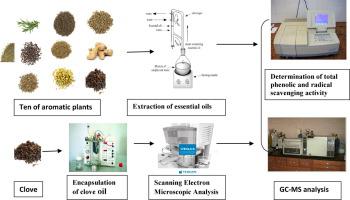当前位置:
X-MOL 学术
›
Arab. J. Chem.
›
论文详情
Our official English website, www.x-mol.net, welcomes your feedback! (Note: you will need to create a separate account there.)
Correlation between chemical composition and radical scavenging activity of 10 commercial essential oils: Impact of microencapsulation on functional properties of essential oils
Arabian Journal of Chemistry ( IF 6 ) Pub Date : 2020-08-01 , DOI: 10.1016/j.arabjc.2020.06.034 Hoda Hanem Mohamed Fadel , Ahmed H. El-Ghorab , Ahmed M.S. Hussein , Khaled F. El-Massry , Shereen Nazeh Lotfy , Mohamad Yehia Sayed Ahmed , Tarek Nour Soliman
Arabian Journal of Chemistry ( IF 6 ) Pub Date : 2020-08-01 , DOI: 10.1016/j.arabjc.2020.06.034 Hoda Hanem Mohamed Fadel , Ahmed H. El-Ghorab , Ahmed M.S. Hussein , Khaled F. El-Massry , Shereen Nazeh Lotfy , Mohamad Yehia Sayed Ahmed , Tarek Nour Soliman

|
Abstract A comparative study was carried out on the essential oils of 10 aromatic plants that are extensively used in Egypt for their distinctive aroma and functional properties. Each essential oil (EO) was characterized by means of gas chromatography-mass spectrometry (GC–MS) analysis and evaluated for its radical scavenging activity by 2,2-diphenyl-1-picrylhydrazyl (DPPH) and 2,2-azinobis (2-ethyl-benzolhiaxoline-6-sulfonic acid)(ABTS) assays. The phenolic content of the 10 EOs was in the descending order: clove > thyme > majoram > basil > anise > chamomile > cinnamon > dill > ginger > rosemary. The radical scavenging activity of the EOs was correlated to the presence of phenolic compounds, such as eugenol, thymol, carvacrol and trans-anethol, or the synergism between the antioxidant activity of nonphenolic compounds such as terpinene-4-ol, α-terpinene, curcumene and chamazulene. Clove essential oil exhibited the highest oil content and radical scavenging activity so it was encapsulated, separately, in three coating materials. Sodium alginate showed the highest retention, encapsulation efficiency and loading capacity of clove EO. Microencapsulation in sodium alginate and chitosan improved the antioxidant activity and phenolic content of the encapsulated clove EO compared with carboxymethyl cellulose. The results support the possibility of using the encapsulated EOs as natural and easy handle antioxidants.
中文翻译:

10 种商业精油化学成分与自由基清除活性的相关性:微胶囊化对精油功能特性的影响
摘要 对埃及广泛使用的 10 种芳香植物的精油进行了比较研究,这些植物具有独特的香气和功能特性。每种精油 (EO) 均通过气相色谱-质谱 (GC-MS) 分析进行表征,并通过 2,2-二苯基-1-苦基肼 (DPPH) 和 2,2- azinobis (2 -乙基-苯并噻唑啉-6-磺酸)(ABTS) 测定。10 种 EO 的酚类含量依次为:丁香>百里香>majoram>罗勒>茴香>洋甘菊>肉桂>莳萝>生姜>迷迭香。EOs 的自由基清除活性与酚类化合物的存在有关,如丁香酚、百里酚、香芹酚和反式茴香脑,或非酚类化合物如萜品烯-4-醇、α-萜品烯、姜黄烯和查马祖烯的抗氧化活性之间的协同作用。丁香精油表现出最高的油含量和自由基清除活性,因此它被分别包裹在三种涂层材料中。海藻酸钠显示出最高的丁香 EO 保留、包封效率和负载能力。与羧甲基纤维素相比,海藻酸钠和壳聚糖的微胶囊化提高了包封的丁香 EO 的抗氧化活性和酚类含量。结果支持使用封装的 EO 作为天然且易于处理的抗氧化剂的可能性。在三种涂层材料中。海藻酸钠显示出最高的丁香 EO 保留、包封效率和负载能力。与羧甲基纤维素相比,海藻酸钠和壳聚糖的微胶囊化提高了包封的丁香 EO 的抗氧化活性和酚类含量。结果支持使用封装的 EO 作为天然且易于处理的抗氧化剂的可能性。在三种涂层材料中。海藻酸钠显示出最高的丁香 EO 保留、包封效率和负载能力。与羧甲基纤维素相比,海藻酸钠和壳聚糖的微胶囊化提高了包封的丁香 EO 的抗氧化活性和酚类含量。结果支持使用封装的 EO 作为天然且易于处理的抗氧化剂的可能性。
更新日期:2020-08-01
中文翻译:

10 种商业精油化学成分与自由基清除活性的相关性:微胶囊化对精油功能特性的影响
摘要 对埃及广泛使用的 10 种芳香植物的精油进行了比较研究,这些植物具有独特的香气和功能特性。每种精油 (EO) 均通过气相色谱-质谱 (GC-MS) 分析进行表征,并通过 2,2-二苯基-1-苦基肼 (DPPH) 和 2,2- azinobis (2 -乙基-苯并噻唑啉-6-磺酸)(ABTS) 测定。10 种 EO 的酚类含量依次为:丁香>百里香>majoram>罗勒>茴香>洋甘菊>肉桂>莳萝>生姜>迷迭香。EOs 的自由基清除活性与酚类化合物的存在有关,如丁香酚、百里酚、香芹酚和反式茴香脑,或非酚类化合物如萜品烯-4-醇、α-萜品烯、姜黄烯和查马祖烯的抗氧化活性之间的协同作用。丁香精油表现出最高的油含量和自由基清除活性,因此它被分别包裹在三种涂层材料中。海藻酸钠显示出最高的丁香 EO 保留、包封效率和负载能力。与羧甲基纤维素相比,海藻酸钠和壳聚糖的微胶囊化提高了包封的丁香 EO 的抗氧化活性和酚类含量。结果支持使用封装的 EO 作为天然且易于处理的抗氧化剂的可能性。在三种涂层材料中。海藻酸钠显示出最高的丁香 EO 保留、包封效率和负载能力。与羧甲基纤维素相比,海藻酸钠和壳聚糖的微胶囊化提高了包封的丁香 EO 的抗氧化活性和酚类含量。结果支持使用封装的 EO 作为天然且易于处理的抗氧化剂的可能性。在三种涂层材料中。海藻酸钠显示出最高的丁香 EO 保留、包封效率和负载能力。与羧甲基纤维素相比,海藻酸钠和壳聚糖的微胶囊化提高了包封的丁香 EO 的抗氧化活性和酚类含量。结果支持使用封装的 EO 作为天然且易于处理的抗氧化剂的可能性。



























 京公网安备 11010802027423号
京公网安备 11010802027423号